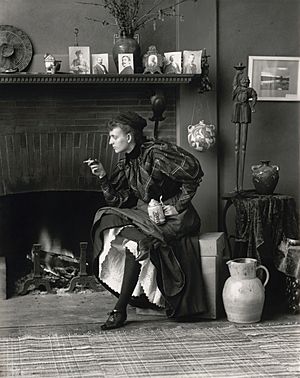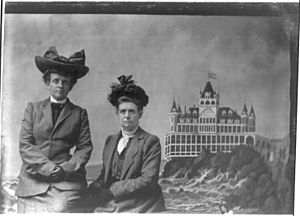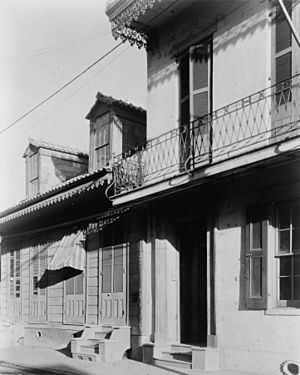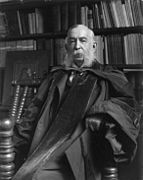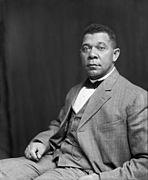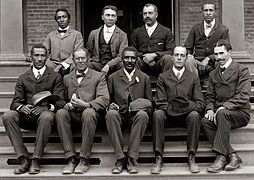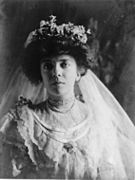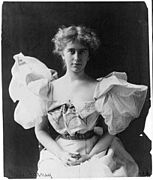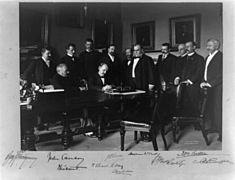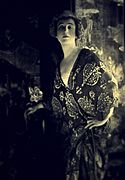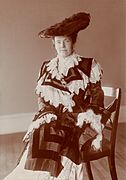Frances Benjamin Johnston facts for kids
Quick facts for kids
Frances Benjamin Johnston
|
|
|---|---|
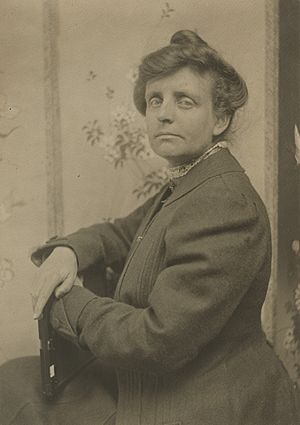
Johnston in 1905
|
|
| Born |
Frances Benjamin Johnston
January 15, 1864 Grafton, West Virginia, U.S.
|
| Died | May 16, 1952 (aged 88) New Orleans, Louisiana, U.S.
|
Frances Benjamin Johnston (born January 15, 1864 – died May 16, 1952) was an important American photographer. She was also a photojournalist, which means she took pictures for news stories. Her career lasted for almost 50 years. She is famous for her portraits, photos of old buildings in the South, and pictures of African Americans and Native Americans around the year 1900.
Contents
Who Was Frances Benjamin Johnston?
Frances Benjamin Johnston was born in Grafton, West Virginia. She was the only child of wealthy parents who lived in Washington, D.C. Her mother, Frances Antoinette Benjamin, was from Rochester, New York. Her father, Anderson Doniphan Johnston, was from Maysville, Kentucky.
Frances's mother was one of the first women to write about national news. She also wrote about plays for the Baltimore Sun newspaper. Her father worked for the government in the Treasury Department for over 30 years.
Frances grew up in Washington, D.C., and went to private schools. In 1883, she graduated from Notre Dame of Maryland Collegiate Institute. Later, she studied art in Paris, France, and at the Washington Art Students League.
How Did Frances Start Her Photography Career?
Frances first started writing articles for magazines. But she soon found her true passion in photography. She received her first camera from George Eastman, a family friend. He was the inventor of the new, lighter Eastman Kodak cameras.
She learned about photography and how to develop pictures from Thomas Smillie. He was the director of photography at the Smithsonian Museum.
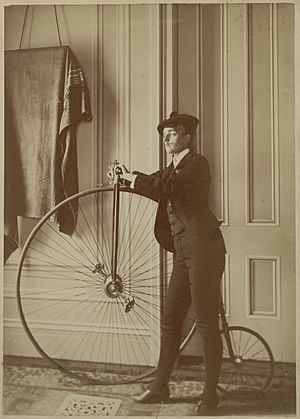
Frances began by taking pictures of her friends, family, and local people. In the 1890s, she worked as a freelance photographer and traveled around Europe. She used her connection to Thomas Smillie to visit other famous photographers. She also collected items for the Smithsonian's museum.
She gained more experience working for the Eastman Kodak company in Washington, D.C. She helped develop film and advised customers on camera repairs. In 1894, she opened her own photo studio in Washington, D.C. At that time, she was the only woman photographer in the city.
Famous People Frances Photographed
Frances took portraits of many famous people. These included Susan B. Anthony, who fought for women's rights. She also photographed writer Mark Twain and Booker T. Washington. He was the head of the Tuskegee Institute.
Because she knew many important people, magazines asked her to take "celebrity" photos. She took Alice Roosevelt's wedding picture. Alice was President Theodore Roosevelt's daughter. People called Frances the "Photographer to the American court."
She photographed Admiral Dewey on his ship, the USS Olympia. She also took pictures of President Theodore Roosevelt's children playing with their pony at the White House. She even photographed the beautiful gardens of Edith Wharton's home near Paris.
Frances grew up knowing many people in Washington's political world. This helped her become the official White House photographer. She worked for Presidents Harrison, Cleveland, McKinley, "TR" Roosevelt, and Taft.
One of her most famous photos is a self-portrait. It shows her as a "New Woman", with her petticoats showing and holding a beer mug. This picture showed her independent spirit.
Helping Women in Photography
Frances believed that women could succeed in photography. In 1897, the Ladies' Home Journal published her article. It was called "What a Woman Can Do With a Camera." It explained how women could find artistic and financial success in photography.
With Zaida Ben-Yusuf, Frances helped organize an exhibition in Paris in 1900. It showed photographs by 28 women photographers. This exhibition later traveled to Russia and Washington, D.C.
Frances traveled a lot in her thirties. She took many documentary and artistic photos. She photographed coal miners, iron workers, and women working in textile factories. She also took pictures of sailors getting tattoos on ships.
In 1899, Frances was asked to photograph the Hampton Normal and Agricultural Institute in Hampton, Virginia. This project showed the school's success. Her photos of daily life at the school are considered some of her most important work. They were shown at the Exhibit of American Negroes in Paris in 1900.
She also photographed big events like world's fairs and peace treaty signings. Frances took the last portrait of President William McKinley. This was at the Pan-American Exposition of 1901, just before he was assassinated.
In 1913, Frances opened a studio in New York City with Mattie Edwards Hewitt. Mattie was also a successful photographer of homes and gardens. Frances's mother and aunt moved into her new apartment.
Frances lectured at New York University about business for women. She and Mattie created many studies of New York City architecture during the 1920s.
Documenting American Architecture
In the 1920s, Frances became very interested in photographing buildings. New York City was changing quickly, and she wanted to record old buildings and gardens that were being torn down.
Her focus on architecture grew, and she became interested in documenting buildings in the American South. Frances wanted to save the history of everyday life in the South through her art. She photographed barns, inns, and other ordinary structures. She was not as interested in grand mansions. Instead, she focused on quickly decaying buildings that showed the daily life of common Southerners. Her photographs are still important for architects, historians, and people who work to save old buildings today.
In 1928, she showed 247 photographs of Fredericksburg, Virginia. These pictures ranged from old mansions to small shacks. The exhibition was called Pictorial Survey—Old Fredericksburg, Virginia. It was described as a way to record history and capture the feeling of an old Virginia town.
Because of this exhibition, the University of Virginia hired her to photograph its buildings. The state of North Carolina also asked her to record its architectural history. Louisiana hired Frances to document its many old plantations that were falling apart.
In 1933, she received a grant from the Carnegie Corporation of New York. This grant allowed her to document early architecture in Virginia. This led to more grants and photos in eight other southern states. Copies of all her photos from these projects were given to the Library of Congress for public use. In December 1935, Frances started a project to photograph historic buildings from the Colonial Era in Virginia. This project was supposed to last one year, but it became an eight-year-long effort. She traveled 50,000 miles and surveyed 95 counties in Virginia.
Later Life and Legacy
Frances Benjamin Johnston was made an honorary member of the American Institute of Architects. This was for her work in saving old and endangered buildings. Her photo collections have been bought by major museums. These include the Metropolitan Museum of Art and the Virginia Museum of Fine Arts.
Even during World War II, when gas was rationed, Frances continued to photograph. She bought a house in the French Quarter of New Orleans in 1940. She retired there in 1945. Frances Benjamin Johnston died in New Orleans in 1952 at the age of 88.
Gallery
-
Booker T. Washington, around 1895.
-
George Washington Carver (front row, center) with faculty of Tuskegee Institute, around 1902.
-
Natalie Clifford Barney, between around 1890 and 1910.
-
"Signing of the Protocol," marking the end of fighting between the US and Spain in the Spanish–American War.
See also
 In Spanish: Frances Benjamin Johnston para niños
In Spanish: Frances Benjamin Johnston para niños


